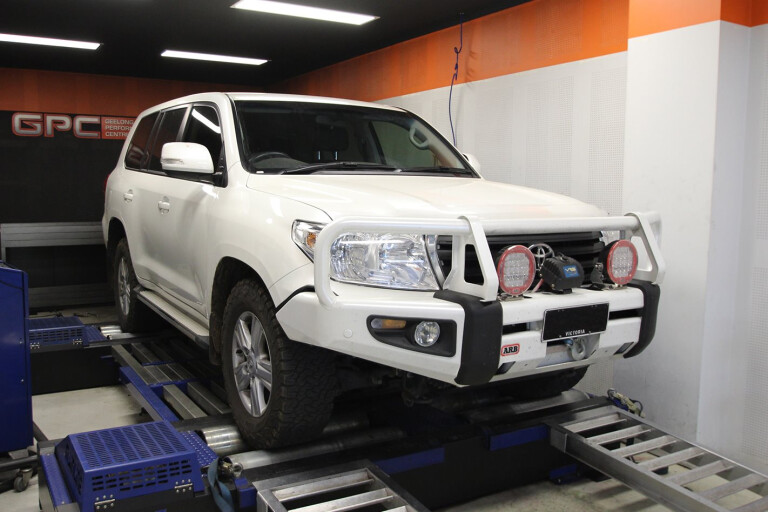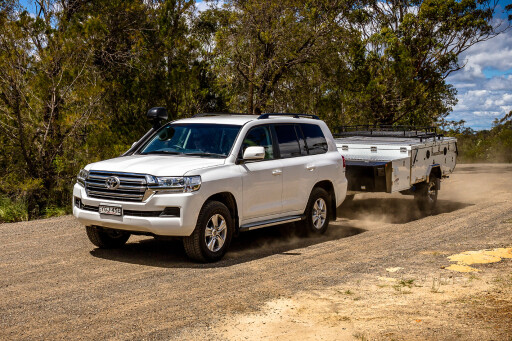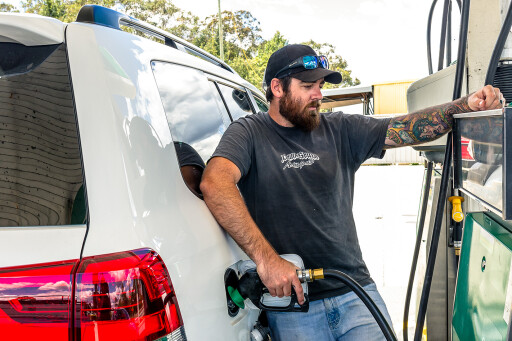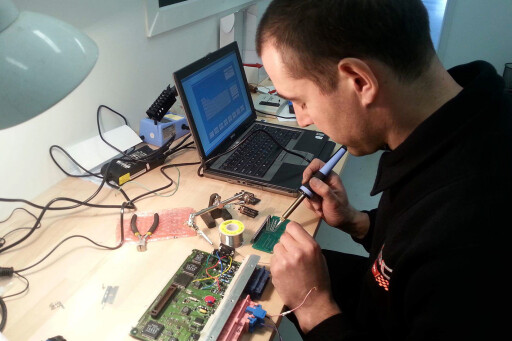
WE LIVE in a digital age. Like it or not, there’s always at least one computer helping us get to wherever we’re going.
It’s the reason 4x4s use less fuel than ever before; it’s the reason they’re more powerful; and it’s the reason every time I look at my phone it’s full of photos of people’s lunch. Sarah Connor tried to warn us about this, but until the day computers finally rise up and enslave us all, we might as well make them work for us.
 We spoke to Paul Farrell from Geelong Performance Centre earlier this year for our ECU re-mapping article (April, 2017) and it turns out he’s big on another kind of remapping, and one you might not have heard of.
We spoke to Paul Farrell from Geelong Performance Centre earlier this year for our ECU re-mapping article (April, 2017) and it turns out he’s big on another kind of remapping, and one you might not have heard of.
Just like your engine, your automatic transmission is precisely controlled by a CU. Everything from what rpm it shifts at, to how hard it shifts, to when the torque convertor locks up, is all controlled by a file full of ones and zeros. And just like the ECU controlling your engine, a knowledgeable person with the right tools can weave their magic to make your transmission work better than ever.
TRANSMISSION REMAP EXPLAINED
SOUNDS great in theory, right? And it is, except the factory doesn’t always get things right. One of the worst offenders is the LC200. Out of the box it performs reasonably well from first gear all the way through to fourth, then it all falls apart.
The torque convertor locks in way too late, then it holds fifth gear from 70km/h to around 120km/h before it’ll finally lug over into sixth. If you’ve got larger tyres, you’ll rarely use sixth. This is where ECU remapping comes into play.
“What we do is read the factory calibration in the ECU,” Paul Farrell told us. “We can then go through and change whatever needs attention.”
 With the factory file pulled out of the ECU, the tuner can change the transmission’s behaviour. The most common changes are locking up the torque convertor earlier, making it hold gears longer and making it click over into a gear earlier to use the full range of ratios through normal operation.
With the factory file pulled out of the ECU, the tuner can change the transmission’s behaviour. The most common changes are locking up the torque convertor earlier, making it hold gears longer and making it click over into a gear earlier to use the full range of ratios through normal operation.
These remaps shouldn’t come as too much of a surprise either; they’re essentially what happens when you kick your stock auto shifter over into sport mode and it holds gears. A good tuner will leave one of the stock maps alone so you can always kick back to factory settings if you’re concerned.
HOW IT ALL WORKS
A MANUAL gearbox is a simple and straightforward affair; each gear has its own cog in the box, a big lever shifts them, power ensues. Automatic transmissions are a little more complicated. Rather than specific cogs for each ratio, they use planetary gears much like you find in a winch, with one feeding into the next. By using a series of brakes and clutches, the ’box is able to control what gears are engaged and what the final ratio will be.
The clutch has a complicated alternative, too. Up front, a torque convertor acts like two fans pointing at each other; although, they pump fluid not air. It lets the engine-side fan spin harder and harder until the transmission-side fan starts turning, which is what provides torque multiplication and what stops the 4x4 from stalling when you come to a stop.
 At certain speeds the transmission can completely lock the torque convertor, giving you direct drive to the ’box. What’s all this got to do with programming?
At certain speeds the transmission can completely lock the torque convertor, giving you direct drive to the ’box. What’s all this got to do with programming?
Back when stubbies were in fashion and VL Commodores were considered high-tech, the transmission controlled all these different operations by pumping transmission fluid through complicated valve bodies that’d engage the different clutch packs, giving different gear ratios. This complicated system has now been replaced with simpler solenoids, all controlled by the CU.
The CU relies on a whole bunch of inputs, with everything from the throttle position and road speed to how many corners you’ve just taken all being considered before it’ll kick up or down a gear. The result is a more intelligent transmission that does what you want, when you want it, and one that can be easily modified without even dropping the fluid.
THE BENEFITS
THERE’S nothing worse than modifying for the sake of modifying, so what exactly is the real-world benefit of all this? In the case of the LC200, the biggest benefit is fuel savings. While torque multiplication is fantastic at low-speed off-roading, it does mean your engine is turning faster than it otherwise needs to, especially at freeway speeds. Locking up the torque convertor drops rpms, leading to a decrease in fuel consumption.
Changing the shift points gives a huge boost to driveability, too. At freeway speeds in an LC200, you no longer need to push through the speed limit to get it to drop into sixth gear. Paul’s modifications see it click into top slot a hair under 100km/h for huge fuel consumption savings – customers report a 2.0 to 3.0L/100km decrease in usage.
 The same modifications allow the transmission to hold top gear under more load to avoid it juggling between fifth and sixth whenever there’s a slight rise in the road, and it will also lock the torque convertor earlier in fifth for a more direct drive and improved consumption figures.
The same modifications allow the transmission to hold top gear under more load to avoid it juggling between fifth and sixth whenever there’s a slight rise in the road, and it will also lock the torque convertor earlier in fifth for a more direct drive and improved consumption figures.
A hidden benefit to locking the torque convertor earlier in the rev range is a reduction in heat. While the torque convertor is the key to making an auto transmission work smoothly, they also create heat when there’s an imbalance in speeds between the two sides.
Locking it up when that slip isn’t required helps reduce the heat produced, giving the transmission fluid a longer life and helping minimise wear on the ’box. Who said you can’t have your cake and eat it?
DOES IT HELP OFF-ROAD?
IF YOU’RE after a serious improvement in off-road ability, you might be a little disappointed. A transmission remap is about getting the auto to work how it should from factory. The problem is, most autos are near-on perfect already at slow-speed work. The torque convertor slipping is a positive thing that acts like reduction gears. As the torque convertor slips, you’re able to get the engine making peak torque while still keeping wheel speed low.
In some situations, like steep descents, momentarily locking the torque convertor can give you more engine brake; but the best off-road modification for an auto slush-box is still a large external cooler to keep temperatures under control.
 That said, if you’re racking up the kays doing serious touring or towing, these modifications can save you huge amounts at the fuel bowser, and with lower running temperatures will make towing in hot conditions less of a concern. Both your wallet and peace of mind will benefit.
That said, if you’re racking up the kays doing serious touring or towing, these modifications can save you huge amounts at the fuel bowser, and with lower running temperatures will make towing in hot conditions less of a concern. Both your wallet and peace of mind will benefit.
Paul did offer a little caution for people heading to their local Facebook tuner. “It’s very easy to stuff up,” he said. “There are countless hours in figuring out what does what, and getting it wrong can make the transmission perform worse than stock.”
SHOULD YOU REMAP YOUR TRANSMISSION?
SOME modifications are absolute no-brainers; if you’re heading bush without a winch, you’re probably a little light-on in the grey matter department. Others are situational. If you need them then they’re the best thing you’ve ever done; if you don’t, it’s throwing money away. A transmission remap is one that falls firmly into the second category.
If you find yourself doing a lot of long-haul driving, especially loaded with a camper, a transmission remap can literally pay for itself with fuel savings alone. The fuel savings on a trip to Cape York can easily save you in the hundreds, depending on where you’re travelling from.
 That said, in the case of the LC200, the main benefits are only felt when you’re high in the gears. If you’re just puttering around town, then this may not be at the top of your to-do list.
That said, in the case of the LC200, the main benefits are only felt when you’re high in the gears. If you’re just puttering around town, then this may not be at the top of your to-do list.
The other main issue is that not every 4x4 has a problem that needs correcting. The LC200 is the main offender, with many others either spot-on from the factory or hydraulically controlled and only upgradeable with a valve body change. Paul let slip, however, that they’ve been pounding out the kays trying to get Nissan’s NP300 Navara shifting better.
CONTACTS
GEELONG PERFORMANCE CENTRE
4 Tarkin Court, Bell Park, VIC, 3215
PHONE: (03) 5277 2503
WEB: geelongperformance.com.au

COMMENTS